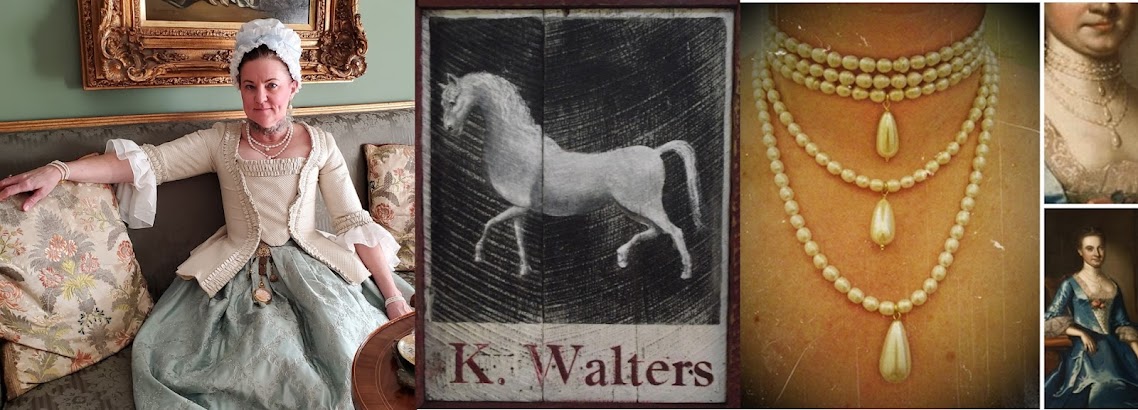Review:
Tea in 18th Century
America
Kimberly K. Walters
By Lynn Price
Assistant Research
Professor, University of Virginia
Assistant Editor, The
Washington Papers
Kimberly
K. Walters is well known and respected in the living history community for her
myriad roles and contributions. As the owner of the Sign of the Gray Horse,
Walters designs and reproduces historically inspired jewelry—with all proceeds
going to rescued horses—that has been used in television shows and
documentaries, on book covers, and at events throughout the United States and
abroad. She is also a prolific living historian, belonging to several military
reenactment units, portraying various personas at historic sites, and teaching
and demonstrating her skills as a master cook with authentic recipes. Walters'
first book, A Book of Cookery, by a Lady, is an extension of her expertise in 18th
century open hearth cooking. Her newest work, Tea in 18th Century America,
highlights her research as an historian focusing on colonial America and the
early republic through the lens of tea and its social, cultural, economical, and
political impact on the new nation.
Tea in
18th Century America begins with the history of tea in England and its arrival
in North America, tracing its ebbs and flows in popularity and the cultural
meaning attached to its use. The book then brings tea alive for the modern
reader, offering recipes of meals to take with tea and desserts, and even a
chapter on historical measurements to assist with recreating such recipes—for
those of us who may not be entirely familiar with the size that corresponds
with "As Thin as a Shilling"! Tea concludes with a biographical
chapter on Margaret Tilghman Carroll, to whom the book is dedicated, and her
life through recipes. Readers will find an extensive variety of primary sources
consulted and quoted, including newspaper advertisements, poems espousing the
virtues of tea, correspondence, diaries, financial accounts, legal acts, and
paintings that together create a vivid narrative.
Tea in
18th Century America offers insights that span a wide range of topics and
interests. Walters' examination of pre-revolutionary America and the power of
tea as a symbol of tyranny or patriotism sheds light on the creation of an
American identity. Her clear explanations of legal acts and taxes on
commodities set the stage for Americans' outrage over the monopoly held by the
East India Tea Company and the beverages' drop in popularity as revolutionary
sentiments grew. To drink tea became a political act. Walters also includes the
important aspect of material culture that is vital to understanding tea as a
commodity. Enjoying tea required tea sets, teapots, spoons, tea chests, and
various other accoutrements, markers of class and financial status. Taking tea,
Walters illustrates, was often a performative act in social settings, with
rules to be followed and customs to learn. Tea was so much more than a
delightful hot beverage.
Novices to
the world of tea need not hesitate to approach Tea in 18th Century America.
Nothing is assumed, and practical knowledge included in the work adds to its
educational benefits. A simple list of tea varieties of the 18th century and
definitions of the words associated with tea sends the reader away with
valuable historical knowledge. For example, Walters' writes that in the era,
"a dish of tea was in reality a cup of tea, for the word 'dish' meant a
cup or vessel used for drinking as well as a utensil to hold food at
meals" (65). Once the reader is fully introduced to the world of 18th
century tea, historical recipes ("receipts" in contemporary vernacular)
with detailed instructions invite readers to step back in time and take tea in
a new way for modern Americans. Thankfully, a chapter of cooking terms and
definitions provides additional help for the less culinary inclined of us.
Kimberly
Walters offers a well researched, well written, and enlightening history of tea
in 18th century America in one manageable volume. Tea in 18th Century America's
usefulness to historians, living historians, interpreters, reenactors, and
others in the field is clear, as is its interest to history fans and tea fans
alike. For a beverage that inspired such words as, "And I lift you to my
lip, And, like nectar, thee I sip; Oh! how charming is the bliss Of thy
aromatic kiss!" (20) should never be resigned to the past.

